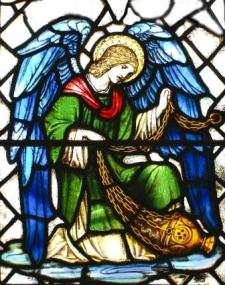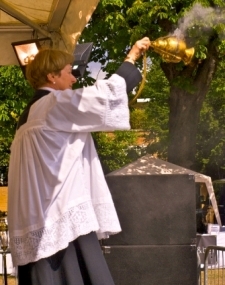
Incense
The Master of Ceremonies, Cathie James (below), explains what you see in the sanctuary.
What is incense?
Incense is made from various resins or gums which when burned give off scented smoke. The incense itself is in the form of grains which are burned on a base of red hot charcoal in a vessel called a thurible or censer.
Why do we use incense in our services?
In the AngloCatholic liturgy we engage all our senses in the worship of God. Symbols and signs help us point our minds to the invisible in ways that are richer than words alone. As a symbol incense is exceptionally rich in association – the Three Kings bringing frankincense as a gift to the Christ child, and the image from the Book of Revelation of ‘golden bowls full of incense, which are the prayers of the Saints’.
Incense symbolises three aspects of our worship. It signifies the presence of God; it is a symbol of prayer and it is a sign of offering.
The rising of the smoke signifies our prayers rising up to God and its perfumed smell evokes a sense of God’s presence- as the psalmist says in Psalm 141 ‘Let my prayer rise before you like incense’.
When we cense the altar at the beginning of Mass we are acknowledging it as the focus of our worship, we are gathering where Christ is known.
In the Orthodox Church you will see the priest cense the gifts of bread and wine, the offering to God, and then all the icons on the screens and walls and then the people who are of course made in the icon (the image) of God. In our worship, in the words of the post communion prayer, ‘we offer ourselves as a living sacrifice’ and this offering of our lives to God is expressed through the censing of those in the sanctuary and the congregation.
Incense has been used by the Christian church for centuries – it is a link to our past, a connection to God in our present, and a pointer to our future hope of heaven.
When do we use incense?
At St Michael’s you will see incense used at particular points during Sunday Mass associated with its symbolism. It is also used at the service of Benediction, some funerals and on other occasions when objects, people or places are blessed.
Who is responsible for the incense during a service?
 The incense is burned in a censer or thurible, which is a metal bowl on chains with a cover that can be lifted up so that the priest can put incense grains onto the hot charcoal. The bearer of the thurible is called the thurifer. This is probably the most difficult job on the serving team. Not only do you have to be able to keep the charcoal alight throughout the service and be careful to avoid burning yourself and/or the priest, but you also have to cope with opening and closing the thurible, often one handed, without getting its complicated chains tangled and all this before even thinking about how to cense others. Add to that responsibility for leading the sanctuary procession in and out, thus having to set the pace, and you can see why it is not a job for the faint hearted. It is an art impossible to describe, which can only be learned by practice and is a task for the ‘graduate’ server.
The incense is burned in a censer or thurible, which is a metal bowl on chains with a cover that can be lifted up so that the priest can put incense grains onto the hot charcoal. The bearer of the thurible is called the thurifer. This is probably the most difficult job on the serving team. Not only do you have to be able to keep the charcoal alight throughout the service and be careful to avoid burning yourself and/or the priest, but you also have to cope with opening and closing the thurible, often one handed, without getting its complicated chains tangled and all this before even thinking about how to cense others. Add to that responsibility for leading the sanctuary procession in and out, thus having to set the pace, and you can see why it is not a job for the faint hearted. It is an art impossible to describe, which can only be learned by practice and is a task for the ‘graduate’ server.
Accompanying the thurifer you will often see a youngster, the so called ‘boat boy’ (although often a girl) , carrying the incense boat (a metal holder with a spoon and hinged lid), – their job is to present the incense to the priest.
Who and what is censed during Sunday Mass and when?
- The altar and cross are censed at the beginning of the service
- The Gospel book is censed and incense burned during the proclamation of the Gospel
- The altar and cross, the gifts to be consecrated, the sacred ministers, servers, choir and the people are all censed during the Eucharistic prayer
- The consecrated bread and wine, Christ’s body and blood, are censed as they are elevated during the Eucharistic prayer
If you watch very carefully, you will see there is a specific pattern to how the altar and the gifts are incensed by the celebrant priest.
When censing a particular person or object, the number of swings of the thurible varies: the following is the practice at St Michael’s.
Three doubles: for the celebrant and concelebrant priests, the book of Gospels, the altar cross (and the Easter (Paschal) candle if it is on the platform) and at the elevation of the consecrated bread and wine
Two doubles: for non celebrant priests and the deacon
One double: for subdeacons, servers, choir and congregation
Blessing the incense
At Sunday Mass it is the celebrant priest who places the incense on the charcoal in the thurible and each time he does so he offers a blessing. The first application takes place in the vestry before the procession enters the church. As the priest approaches the thurifer, the ‘boat boy’ presents the boat and says ‘Pray Father (or Mother) a blessing’. The priest then places the incense grains in the open thurible saying ‘Be blessed by him in whose honour you shall be burned’ ('Ab illo benedicaris in cuius honore cremaberis' for the Latin scholars) and makes the sign of the cross. The thurible lid is then closed.
The second application takes place immediately before the Gospel procession – you will see the thurifer and boat boy approach the celebrant at his chair and the same blessing is made.
The third application takes place immediately before the Eucharistic prayer – again the thurible and boat is brought to the celebrant priest and a blessing is requested. A different prayer is frequently offered at this point:
‘At the intercession of the Blessed Michael the Archangel who stands at the right hand of the altar of incense, may the Lord graciously accept this fragrant offering to his praise and glory’
So next time you are at Mass, watch the actions of the thurifer and ‘boat boy’ (or girl!), appreciate their symbolism and tradition, and let the perfumed fragrance of the incense lift your thoughts towards the mystery of God’s presence.
My grateful thanks to Father Kevin for his help in explaining some of the theological symbolism.

